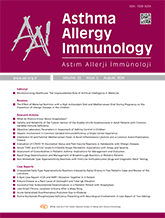


Objective: Familial Mediterranean Fever (FMF) is an autosomal recessive autoinflammatory disease, including reiterative feverish bouts of joint pain, and abdominal and chest pain as a consequence of serosal inflammation. In the course of acute attacks, multifarious proinflammatory cytokines have been depicted to increase. In previous studies, it has been underlined that IL-33, a recent member of the IL-1 cytokine superfamily, has an essential role in the inflammation. Here, we aimed to evaluate serum IL-33 levels in FMF patients to investigate its presumable importance in the FMF formation mechanism.
Materials and Methods: A total of 58 FMF patients (21 females, 37 males; mean age 27.8 ± 5.2 years, mean disease duration 8.2 ± 3.7 years) and 22 healthy controls (10 females, 12 males, mean age 26.5 ± 5.9 years) were incorporated into this research. ELISA was utilized to measure serum IL-33 concentrations.
Results: The mean concentrations of serum IL-33 were 3.88 ± 2.25 pg/ml and 2.89 ± 0.48 pg/ml in the patient and control groups respectively. The mean serum IL-33 concentrations were 5.48 ± 2.13 pg/ml and 2.27 ± 0.36 pg/ml in the active phase and in the inactive phase respectively. According to these results, serum IL-33 concentrations were prominently higher in FMF patients compared with the control group (p<0.01). Moreover, serum IL-33 concentrations were measured significantly higher in the active phase compared with serum IL-33 levels in the inactive phase and controls respectively (p<0.0001 and p<0.0001). The mean serum IL-33 levels in patients with active FMF was associated with arthritis (p<0.05).
Conclusion: To sum up, the high concentrations of serum IL-33 in the active FMF cases propose that IL-33 may operate a remarkable function in the pathogenesis of FMF.